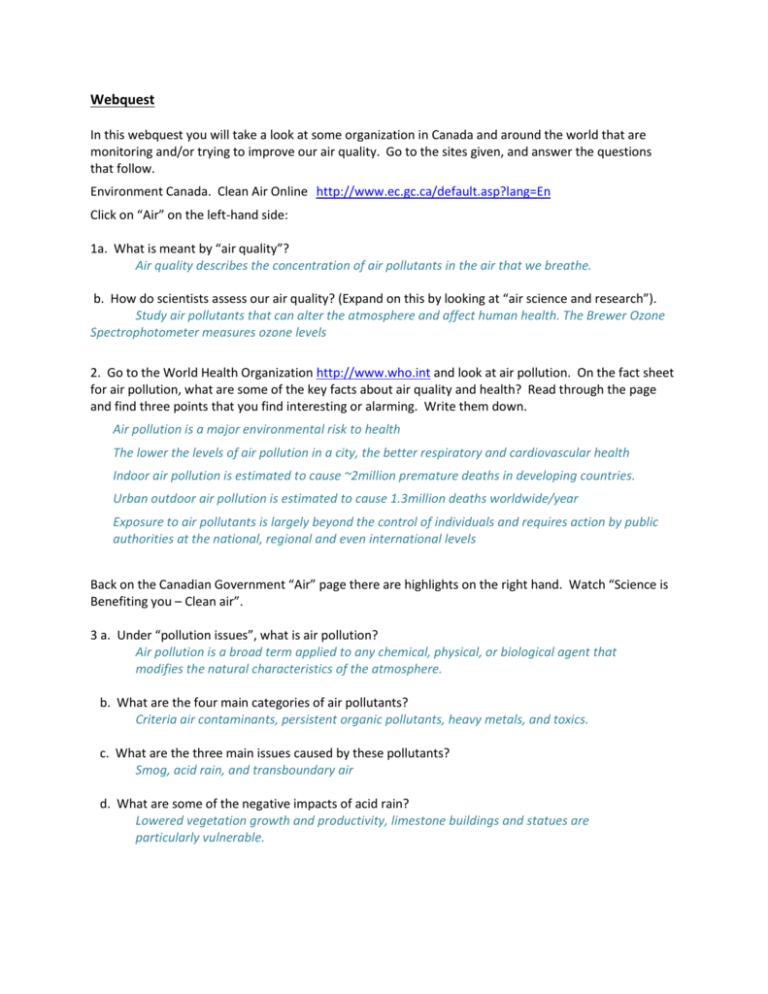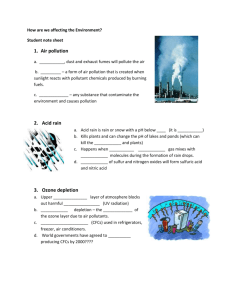File - FRC Chemistry
advertisement

Webquest In this webquest you will take a look at some organization in Canada and around the world that are monitoring and/or trying to improve our air quality. Go to the sites given, and answer the questions that follow. Environment Canada. Clean Air Online http://www.ec.gc.ca/default.asp?lang=En Click on “Air” on the left-hand side: 1a. What is meant by “air quality”? Air quality describes the concentration of air pollutants in the air that we breathe. b. How do scientists assess our air quality? (Expand on this by looking at “air science and research”). Study air pollutants that can alter the atmosphere and affect human health. The Brewer Ozone Spectrophotometer measures ozone levels 2. Go to the World Health Organization http://www.who.int and look at air pollution. On the fact sheet for air pollution, what are some of the key facts about air quality and health? Read through the page and find three points that you find interesting or alarming. Write them down. Air pollution is a major environmental risk to health The lower the levels of air pollution in a city, the better respiratory and cardiovascular health Indoor air pollution is estimated to cause ~2million premature deaths in developing countries. Urban outdoor air pollution is estimated to cause 1.3million deaths worldwide/year Exposure to air pollutants is largely beyond the control of individuals and requires action by public authorities at the national, regional and even international levels Back on the Canadian Government “Air” page there are highlights on the right hand. Watch “Science is Benefiting you – Clean air”. 3 a. Under “pollution issues”, what is air pollution? Air pollution is a broad term applied to any chemical, physical, or biological agent that modifies the natural characteristics of the atmosphere. b. What are the four main categories of air pollutants? Criteria air contaminants, persistent organic pollutants, heavy metals, and toxics. c. What are the three main issues caused by these pollutants? Smog, acid rain, and transboundary air d. What are some of the negative impacts of acid rain? Lowered vegetation growth and productivity, limestone buildings and statues are particularly vulnerable. 4. Click on “Acid Rain”. What are some of the main chemical compounds that contribute to Acid Rain? SO2, and NOx can be transformed into sulfuric acid, ammonium nitrate and nitric acid. 5. On the left, find “Activities to reduce Acid Rain”. Briefly outline Canada’s response to increasing levels of acid rain, both federally and internationally. Canada Acid Rain Program – cap on SO2 production, science and monitoring program, seek reduction of flows of acid pollutants from the US. United Nations Economic Commission for Europe Convention on Long-Range Transboundary Air Pollution 6. On the left, find “Main Emmision Sources”. What is responsible for the majority of the pollutants responsible for acid rain? SO2 – base metal smelters, fossil fuelled power plants, industrial fossil-fuel combustion sources NOx automobiles, trucks, off-road engines, fossil-fuelled power plants, industrial fossil-fuel combustion sources. 7. Return to “Pollution Issues”. What are the two main components of smog? Ground level ozone and particulate matter. 8. What are some of the primary concerns about smog? Health – smog has been identified as contributin factors in thousands of premature deaths across the country each year, as well as increased hospital visits, doctor visits and hundreds of thousands of lost day at work and school. Environmental – problems attributed to smog include effects on vegetation, structures, and visibility and haze 9. Under the main topic “Air”, click on air Quality Health Index. How can you improve air quality? Be a leader, be informed, recycle, water conservation, compositing, fuel-efficient vehicles 10. What is the air quality health index in Winnipeg? Low risk 3 11. Search the Government of Canada site for the Clean Air Agenda. Why was it developed? What are the 5 areas of concern? Reducing transboundary air pollution Reducing transportation sector emissions Reducing major industrial emissions Advancing science Engaging the public 12.Take a look at a global map of air pollution at http://www.esa.int/esaEO/SEM340NKPZD_index_0.html (on the European Space Agency website). Describe what you see. High air pollution around the great lakes, New England, China, Northern Europe, and South Africa.






